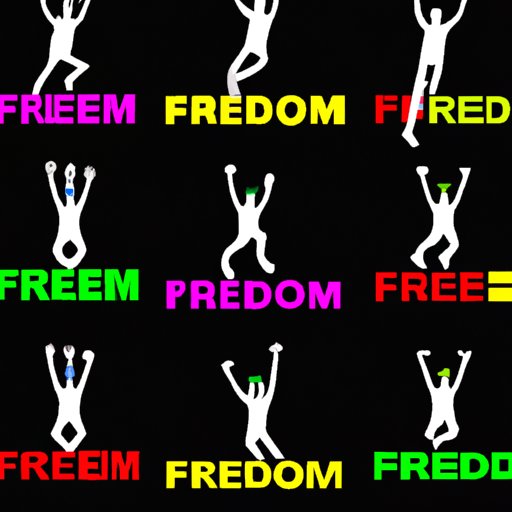Introduction
Freedom is a fundamental human right that everyone should be able to enjoy. From the right to express oneself freely to the right to be free from oppression, there are many aspects of freedom that allow people to lead dignified and meaningful lives. But which country has the most freedom? This article seeks to answer this question by exploring the global landscape of freedom.
In order to accurately measure freedom, it is important to first understand how it is defined. Generally speaking, freedom is the power or right to act, speak, or think as one wants without hindrance or restraint. With this definition in mind, this article will compare freedom of expression in different countries, rank nations according to their levels of personal freedom, analyze the relationship between human rights and freedom, examine the impact of political and social structures on freedom, and explore the role of technology in enhancing or restricting freedom.

Comparing Freedom of Expression in Different Countries
When it comes to evaluating freedom of expression, there are several key indicators to consider. These include access to information and media, government censorship, and the ability to peacefully assemble and protest. By examining these factors, it is possible to get a better understanding of the varying levels of freedom of expression across different countries.
For example, in the United States, citizens enjoy relatively unrestricted access to information and media, with the exception of certain content that is deemed inappropriate for minors. In contrast, China maintains a tight grip on media and internet access, heavily censoring content that is deemed politically sensitive. Similarly, while Americans have the right to peacefully assemble and protest, the same cannot be said for those living in oppressive regimes such as North Korea, where citizens are not allowed to express dissenting views.

Ranking Countries by Level of Personal Freedom
Once the differences between countries in terms of freedom of expression have been identified, it is then possible to rank nations according to their levels of personal freedom. Generally speaking, the most free countries tend to be those that offer their citizens greater civil liberties, protect human rights, and promote democratic values.
At the top of the list are countries such as Norway, Finland, and Switzerland, which all boast high levels of personal freedom and strong commitment to human rights. At the other end of the spectrum are nations such as Syria and Somalia, which have been plagued by conflict and political instability and are considered to be some of the least free countries in the world.
Analyzing the Relationship between Human Rights and Freedom
It is clear that the level of personal freedom enjoyed in a given country is strongly linked to its respect for human rights. International human rights instruments, such as the Universal Declaration of Human Rights, provide a framework for states to adhere to when it comes to protecting the rights of their citizens. When these instruments are implemented effectively, they can help to ensure that individuals are able to exercise their freedoms without fear of persecution or discrimination.
However, there are still many countries around the world that do not fully comply with international standards. In these cases, individuals may be deprived of their basic rights, leading to an environment of oppression and inequality. As such, it is essential that governments prioritize human rights in order to ensure that their citizens are able to enjoy the highest levels of freedom.
Exploring the Impact of Political and Social Structures on Freedom
In addition to human rights, the type of governmental and social structures in place can also have a significant impact on freedom. For instance, countries with authoritarian regimes tend to have fewer civil liberties, as the government typically exercises more control over the population. On the other hand, democracies are generally more open societies that provide greater opportunities for individual freedoms.
Furthermore, the social norms and values of a particular country can also influence the degree of freedom available. In some cultures, for example, women may be restricted from participating in certain activities due to traditional gender roles. In such cases, individuals may not be able to exercise their freedoms to the fullest extent.

Examining the Role of Technology in Enhancing or Restricting Freedom
Finally, it is important to consider the role of technology in enhancing or restricting freedom. On the one hand, technology can be used to facilitate access to information and promote freedom of expression. For example, social media platforms such as Twitter and Facebook have enabled people to share their opinions and engage in debates on a global scale.
On the other hand, technology can also be used to monitor and restrict freedom. Governments may use surveillance systems to track citizens’ movements and censor online content. Additionally, repressive regimes may use technology to suppress dissent and repress minority groups.
Conclusion
In conclusion, this article has explored the global landscape of freedom by comparing different countries, ranking them according to their levels of personal freedom, and analyzing the relationship between human rights and freedom. It has also examined the impact of political and social structures on freedom, as well as the role of technology in enhancing or restricting it.
Overall, the data suggests that there is no single country that can claim to have the most freedom. Instead, levels of freedom vary significantly from one nation to the next depending on a range of factors, including human rights, governmental structures, social norms, and technology. Going forward, it is essential that governments continue to prioritize human rights and create an environment in which citizens can enjoy the highest levels of freedom.


